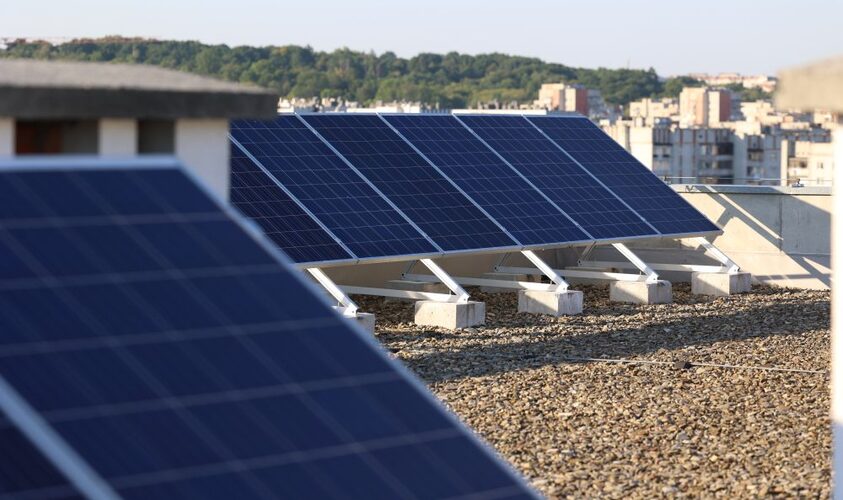Setting up a solar power plant in 2 months: the experience of Greenwood-2 housing cooperative, which used city and state co-financing programmes
A rooftop solar power plant has already started operating in two 5-storey buildings of the Greenwood-2 housing cooperative (92 Lvivska Street, 92A, Bryukhovychi). To install it, the condominium association used the state programme Green Home and the city’s Warm House programme. The already installed solar panels were used to connect the roof boiler room, two IHS, intercoms, gates and lighting for common areas. According to Olena Pasternak, chairman of the HOA board, the residents are already receiving their first free kilowatts of electricity.
“In the spring, when there were blackouts, we started looking for various programmes that would help condominiums with rooftop boilers to set up a backup power supply. I would like to note that we immediately focused on installing solar panels rather than generators in order not to pollute the environment, as our house is actually located in the forest.
So, in the summer, when I found out about the GreenDom programme from the Energy Efficiency Fund and the city’s Warm House programme, I decided to use them,” says Olena Pasternak, chairman of the board of Greenwood-2 housing cooperative.
She then held a meeting with the residents and explained the two programmes in detail. The residents supported the decision to use them to install a solar power plant for two houses.
“The solar power plant project cost us UAH 2.5 million. And the whole process – from the moment we apply for a loan to the launch of the already installed solar power plant – takes two to two and a half months.
After receiving all the compensation – from the state and the city – the residents of our houses will still have to pay about UAH 4,500. This is for one apartment of about 40 m2.
Given that we will be paying less for electricity in the future, the solar power plant project will pay for itself in 2 years. And now, if there are blackouts in winter, we will have uninterrupted power supply, and free kilowatts of electricity for the next few years,” adds Olena Pasternak.
The solar power plant has powered intercoms, lighting in common areas, gates, IT systems of two buildings and the roof boiler house that supplies heat to these two buildings.
As Serhiy Minzhos, head of Progress Electric, the company that installed the solar power plant, explains, before starting work, they installed energy meters on the roofs of the buildings and measured the actual electricity consumption of the buildings for a certain period. Then, several solar panels were installed for testing purposes and their performance was studied at different angles and locations. After analysing all this, they chose the most convenient placement of the panels to maximise electricity generation.
“Before installing a solar power plant, it is important to make a correct calculation of the electricity consumption of the house. It is necessary to take into account the starting currents, power losses, and shading of the house to achieve the maximum result.
In general, 270-280 days a year, the solar panels will work at their maximum capacity. That is, the electricity they generate will be enough for all the systems we have connected to them. In winter, the generation will be lower, but it will still be 10-20%, even when there is snow on the panels,” explains Sergiy Minzhos.
Thus, for the installation of a solar power plant in the buildings at 92, 92A Lvivska Street, Greenwood-2 housing cooperative will receive compensation from the city budget in the amount of UAH 747 thousand, in accordance with the terms of the Warm Home programme.
According to Sergiy Soltys, head of the condominium support unit at the Lviv City Council’s Department of Housing and Infrastructure, 4 condominiums have already taken advantage of the city’s Warm Home programme to install a solar power plant, and 12 more are planning to do so in the coming months.
“We paid the first compensation for the installation of solar power generation last year. However, this case became more interesting for the residents this year, when the state programme Green Home was launched, which allows them to receive up to 70% compensation for such work. Therefore, in combination with the city’s Warm House programme, which provides up to 30% compensation, residents receive very favourable conditions for the implementation of such a project, as they will have to pay a small amount personally.
Therefore, when you use a combination of these programmes and install a solar power plant in your house, you can power all the critical infrastructure of the building – elevators, ITPs, pumping stations, video surveillance, etc. – and actually ensure the autonomy of the house and independence from the city’s power grid. And this is very important in winter, when blackouts are possible,” emphasises Sergey Soltys.
As a reminder, the city’s Warm Home programme has been in place since 2015. Under this programme, condominiums and housing cooperatives of the city can receive reimbursement of a part of the loan from the budget of the Lviv city territorial community in the amount of up to 30% of the maximum principal amount (body) of the loan, but not more than UAH 1 million under one loan agreement.
In total, from 2015 to October 2024, condominiums and housing cooperatives in Lviv received 304 loans totalling UAH 276.9 million for energy efficiency, reconstruction and modernisation measures in 228 buildings. Reimbursement from the city budget amounted to UAH 46.7 million, including UAH 2.8 million (6 loans) in 2024.

